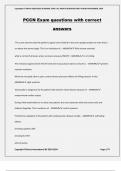Exam (elaborations)
PCCN Exam questions with correct answers
Institution
Practice Tests
PCCN Exam questions with correct
answers
The nurse observes that the patient's jugular veins distend in the semi-upright position to more than 5
cm above the sternal angle. This is an indication of: - ANSWER-fluid volume overload.
what is normal Pulmonary artery occlusion pressure (PAOP)? - ANS...
[Show more]
Preview 4 out of 77 pages
Uploaded on
November 4, 2024
Number of pages
77
Written in
2024/2025
Type
Exam (elaborations)
Contains
Questions & answers
Institution
Practice Tests
Course
Practice Tests
$12.49
100% satisfaction guarantee
Immediately available after payment
Both online and in PDF
No strings attached
Copyright © KAYLIN 2024/2025 ACADEMIC YEAR. ALL RIGHTS RESERVED FIRST PUBLISH NOVEMBER, 2024




